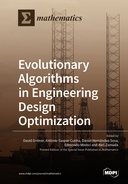Explore

Evolutionary Algorithms in Engineering Design Optimization
0 Ungluers have
Faved this Work
Login to Fave
Evolutionary algorithms (EAs) are population-based global optimizers, which, due to their characteristics, have allowed us to solve, in a straightforward way, many real world optimization problems in the last three decades, particularly in engineering fields. Their main advantages are the following: they do not require any requisite to the objective/fitness evaluation function (continuity, derivability, convexity, etc.); they are not limited by the appearance of discrete and/or mixed variables or by the requirement of uncertainty quantification in the search. Moreover, they can deal with more than one objective function simultaneously through the use of evolutionary multi-objective optimization algorithms. This set of advantages, and the continuously increased computing capability of modern computers, has enhanced their application in research and industry. From the application point of view, in this Special Issue, all engineering fields are welcomed, such as aerospace and aeronautical, biomedical, civil, chemical and materials science, electronic and telecommunications, energy and electrical, manufacturing, logistics and transportation, mechanical, naval architecture, reliability, robotics, structural, etc. Within the EA field, the integration of innovative and improvement aspects in the algorithms for solving real world engineering design problems, in the abovementioned application fields, are welcomed and encouraged, such as the following: parallel EAs, surrogate modelling, hybridization with other optimization techniques, multi-objective and many-objective optimization, etc.
This book is included in DOAB.
Why read this book? Have your say.
You must be logged in to comment.
Rights Information
Are you the author or publisher of this work? If so, you can claim it as yours by registering as an Unglue.it rights holder.Downloads
This work has been downloaded 130 times via unglue.it ebook links.
- 130 - pdf (CC BY) at Unglue.it.
Keywords
- accuracy levels
- Aeroacoustics
- archiving strategy
- artificial neural networks (ANN) limited training data
- Automatic Voltage Regulation system
- availability
- bankruptcy problem
- beam improvements
- beam T-junctions models
- Chaotic optimization
- Classification
- Control
- Design
- differential evolution
- distance-based
- diversity control
- encoding
- evolutionary algorithm
- evolutionary algorithms
- evolutionary optimization
- experimental study
- finite elements analysis
- Fractional Order Proportional-Integral-Derivative controller
- genetic algorithm
- genetic programming
- global optimisation
- global optimization
- Gough–Stewart
- History of engineering & technology
- launchers
- Machine learning
- machine vision
- min-max optimization
- mono and multi-objective optimization
- multi-objective decision-making
- multi-objective evolutionary algorithms
- multi-objective optimisation
- multi-objective optimization
- mutation-selection
- nearly optimal solutions
- neural networks
- non-linear parametric identification
- Optimal Control
- Optimal design
- parallel manipulator
- parameter optimization
- Pareto front
- performance metrics
- plastics thermoforming
- preference in multi-objective optimization
- preventive maintenance scheduling
- Quality control
- real application
- reusable launch vehicle
- robust
- Robust Design
- roughness measurement
- sheet thickness distribution
- space systems
- spaceplanes
- surrogate
- T-junctions
- Technology, engineering, agriculture
- Technology: general issues
- trailing-edge noise
- trajectory optimisation
- two-stage method
- Uncertainty Quantification
- unscented transformation
- worst-case scenario
- Yellow Saddle Goatfish Algorithm
Links
DOI: 10.3390/books978-3-0365-2715-4Editions

